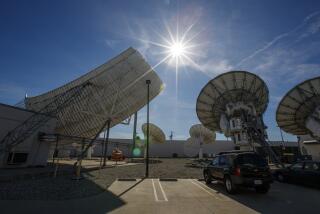10 Cable Firms Agree to Add HDTV by Jan. 1
- Share via
Tackling one of the thorniest problems facing a new generation of broadcasting, the country’s 10 largest cable television companies pledged Wednesday to add high-definition digital TV to their line-ups by next year.
The cable companies, including AT&T; Broadband, AOL Time Warner Inc. and Adelphia Communications Corp., didn’t specify when they would make HDTV available to their customers. But they committed to offering free space in their channel lineups by Jan. 1 to as many as five broadcasters or cable networks that air significant amounts of HDTV.
The pledge marks the first significant progress for the troubled transition to digital TV, which the Federal Communications Commission mandated in 1997. The switch from analog to digital promises clearer pictures, better sound and more sophisticated services, but it forces broadcasters to invest millions of dollars in new equipment and consumers to buy digital TVs.
Yet even Wednesday, cable operators were reluctant to set a date for rolling out the services. And their commitment leaves several disputes among the cable operators, set manufacturers and broadcasters still to be resolved.
FCC Chairman Michael K. Powell praised the cable operators for their “solid commitments,” but broadcasters and set manufacturers were more reserved. Concerned that the cable operators will continue to refuse space for some local digital stations and certain types of programming, Eddie Fritts, chief executive of the National Assn. of Broadcasters, said, “We look forward to the day when cable operators carry all digital broadcast signals in their entirety.”
Illustrating the slow progress of the transition, about 75% of the nation’s 1,300 commercial broadcasters missed the deadline Wednesday for turning on their digital signals. Federal officials said they did not plan to penalize those stations because they expect most to have their digital signals on the air by the end of the year.
Numerous problems have plagued the transition, including the high price of digital sets and the shortage of unique digital programming. Only a handful of over-the-air and cable networks offer HDTV, the most richly detailed form of digital programming, and only the Public Broadcasting Service has used the new technology to offer multiple simultaneous programs.
Perhaps the biggest problem for broadcasters, though, is that two-thirds of their viewers tune in through cable, and most cable operators have refused to carry digital channels. Satellite operators also have been reluctant to carry the local digital offerings, so the only option for many consumers is to put up an antenna.
Last month, Powell tried to breathe life into the transition by setting voluntary deadlines for cable and satellite operators, broadcasters, programmers and set manufacturers. On Wednesday, Robert Sachs, chief executive of the National Cable & Telecommunications Assn., said in a letter to Powell that the top 10 cable operators would comply with most of the chairman’s proposal.
In the 100 largest markets, high-capacity cable systems will offer to carry up to five local stations or cable networks that provide HDTV a substantial portion of the time, Sachs’ letter states.
The cable operators’ commitment didn’t meet Powell’s proposal on one point: They didn’t agree to provide converter boxes with digital connectors by Jan. 1.
Such devices, which consumers may need to tune in premium HDTV programming from Hollywood studios, won’t be widely available until the end of 2003, Sachs said in his letter.
Most cable networks across the country have been upgraded to high-capacity systems, so the pledge could make HDTV available to tens of millions of viewers. But offering to carry a digital station isn’t the same as putting that station in the lineup, as several cable operators pointed out.
“It doesn’t mean that, for sure, on Jan. 1 [HDTV] will be available,” said Amy Cohn, a spokeswoman for Cox Communications Inc.
Noting that a number of contractual and technical issues remain to be resolved, Cohn said, “We will make a good-faith effort to try to have programming available close to that date ... [but] we can’t commit to a definite launch.”
AOL Time Warner is more gung-ho about the new technology. Company officials said they already offer local digital stations and HDTV versions of several cable networks throughout their territories. And almost any customer who signs up for digital cable--the cable industry’s version of digital TV, which is not the same as the broadcasters’ new channels--can obtain a special converter box and tune in HDTV.
More to Read
The biggest entertainment stories
Get our big stories about Hollywood, film, television, music, arts, culture and more right in your inbox as soon as they publish.
You may occasionally receive promotional content from the Los Angeles Times.











